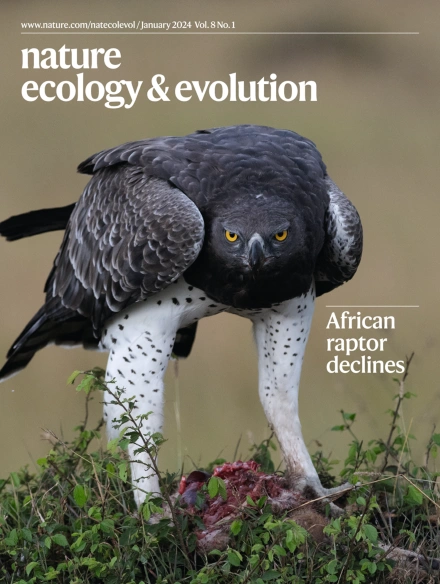Evidence for widespread thermal optimality of ecosystem respiration
IF 13.9
1区 生物学
Q1 ECOLOGY
引用次数: 3
Abstract
Ecosystem respiration (ER) is among the largest carbon fluxes between the biosphere and the atmosphere. Understanding the temperature response of ER is crucial for predicting the climate change–carbon cycle feedback. However, whether there is an apparent optimum temperature of ER ( $${{T}}_{{\rm{opt}}}^{\,{\rm{ER}}}$$ ) and how it changes with temperature remain poorly understood. Here we analyse the temperature response curves of ER at 212 sites from global FLUXNET. We find that ER at 183 sites shows parabolic temperature response curves and $${{T}}_{{\rm{opt}}}^{\,{\rm{ER}}}$$ at which ER reaches the maximum exists widely across biomes around the globe. Among the 15 biotic and abiotic variables examined, $${{T}}_{{\rm{opt}}}^{\,{\rm{ER}}}$$ is mostly related to the optimum temperature of gross primary production (GPP, $${{T}}_{{\rm{opt}}}^{\,{\rm{GPP}}}$$ ) and annual maximum daily temperature (Tmax). In addition, $${{T}}_{{\rm{opt}}}^{\,{\rm{ER}}}$$ linearly increases with Tmax across sites and over vegetation types, suggesting its thermal adaptation. The adaptation magnitude of $${{T}}_{{\rm{opt}}}^{\,{\rm{ER}}}$$ , which is measured by the change in $${{T}}_{{\rm{opt}}}^{\,{\rm{ER}}}$$ per unit change in Tmax, is positively correlated with the adaptation magnitude of $${{T}}_{{\rm{opt}}}^{\,{\rm{GPP}}}$$ . This study provides evidence of the widespread existence of $${{T}}_{{\rm{opt}}}^{\,{\rm{ER}}}$$ and its thermal adaptation with Tmax across different biomes around the globe. Our findings suggest that carbon cycle models that consider the existence of $${{T}}_{{\rm{opt}}}^{\,{\rm{ER}}}$$ and its adaptation have the potential to more realistically predict terrestrial carbon sequestration in a world with changing climate. Temperature response curves of ecosystem respiration from 212 globally distributed sites show widespread evidence for an optimum temperature that is the result of thermal adaptation.

生态系统呼吸广泛热优化的证据。
生态系统呼吸(ER)是生物圈和大气之间最大的碳通量之一。了解ER的温度响应对于预测气候变化碳循环反馈至关重要。然而,是否存在ER的表观最佳温度([公式:见正文])以及它如何随温度变化仍知之甚少。在这里,我们分析了来自全球FLUXNET的212个站点的ER的温度响应曲线。我们发现183个地点的ER显示出抛物线温度响应曲线,ER达到最大值的[公式:见正文]广泛存在于全球生物群落中。在检查的15个生物和非生物变量中,[公式:见正文]主要与初级生产总值的最佳温度(GPP,[公式,见正文])和年最高日温度(Tmax)有关。此外,[公式:见正文]在不同地点和植被类型上随Tmax线性增加,表明其热适应性。[公式:见正文]的适应幅度,通过Tmax每单位变化的[公式:参见正文]的变化来衡量,与[公式:详见正文]的适应性幅度呈正相关。这项研究提供了[公式:见正文]广泛存在的证据,以及它在全球不同生物群落中对Tmax的热适应。我们的研究结果表明,考虑到[公式:见正文]的存在及其适应的碳循环模型有可能更现实地预测气候变化世界中的陆地碳固存。
本文章由计算机程序翻译,如有差异,请以英文原文为准。
求助全文
约1分钟内获得全文
求助全文
来源期刊

Nature ecology & evolution
Agricultural and Biological Sciences-Ecology, Evolution, Behavior and Systematics
CiteScore
22.20
自引率
2.40%
发文量
282
期刊介绍:
Nature Ecology & Evolution is interested in the full spectrum of ecological and evolutionary biology, encompassing approaches at the molecular, organismal, population, community and ecosystem levels, as well as relevant parts of the social sciences. Nature Ecology & Evolution provides a place where all researchers and policymakers interested in all aspects of life's diversity can come together to learn about the most accomplished and significant advances in the field and to discuss topical issues. An online-only monthly journal, our broad scope ensures that the research published reaches the widest possible audience of scientists.
 求助内容:
求助内容: 应助结果提醒方式:
应助结果提醒方式:


